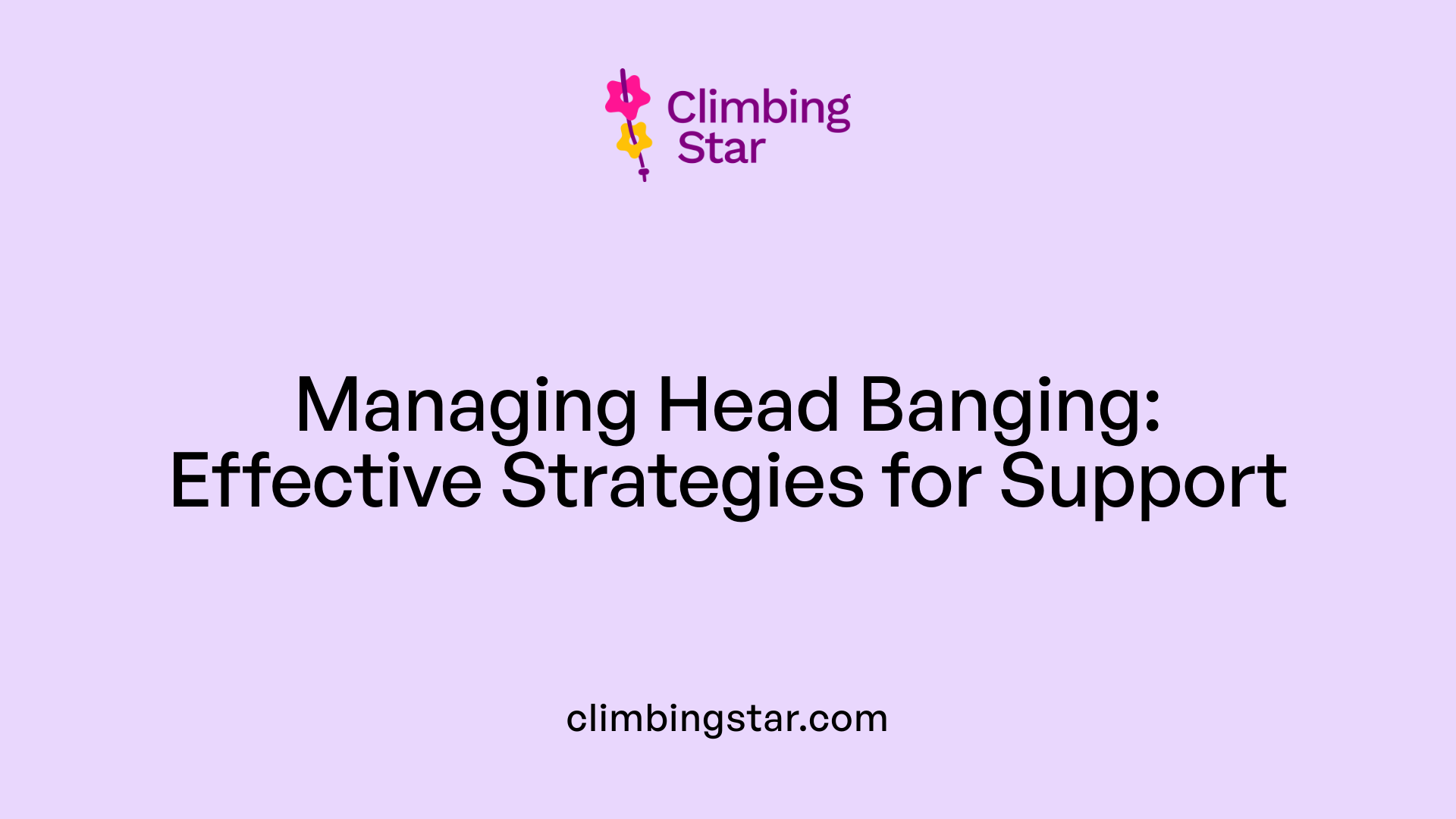A Deep Dive into Head Banging Behaviors
Head banging is a common behavior observed in children with autism spectrum disorder (ASD), often causing concern among caregivers and professionals. This behavior, while distressing, typically serves various functions such as self-soothing, communication, or sensory regulation. Understanding the causes, triggers, and effective management strategies is vital for ensuring the safety and well-being of individuals with autism. This article explores comprehensive insights into head banging, including resources available for caregivers and professionals, safety considerations, and therapeutic options.
Prevalence and Underlying Causes of Head Banging in Autism

How common is head banging among children with autism?
Head banging is quite prevalent among children on the autism spectrum. Studies indicate that approximately 30% of children with autism engage in self-injurious behaviors such as head banging or skin picking at some point in their lives. This behavior often serves as a way for children to manage overwhelming sensory experiences or express unmet needs.
Why do children with autism head bang?
Head banging may stem from sensory processing issues, which are common in autism. Some children use this behavior to seek stimulation—either by stimulating their vestibular system when feeling understimulated—or to counteract sensory overload or hypersensitivity. When overwhelmed by external stimuli, children might head bang to decrease sensory input and regain a sense of control.
Children with communication challenges also often resort to head banging as a non-verbal way to express frustration, discomfort, or pain. For instance, if they are unable to communicate that they are in pain due to an ear infection or headache, they might resort to head banging as a form of expression.
Furthermore, emotional factors such as anxiety, stress, or changes in routine can trigger head banging. Some children may also perform this behavior to attract attention or seek comfort, especially if they have learned that head banging elicits reactions from caregivers.
What causes and reasons behind head banging and other self-injurious behaviors in autistic individuals?
Head banging in children with autism is often caused by sensory processing issues, such as seeking stimulation or trying to cope with sensory overload or deficits. It can also serve as a form of self-soothing in response to frustration, anxiety, or pain, including medical discomfort or communication difficulties.
Triggers for head banging include environmental changes, routine disruptions, overstimulation or understimulation, and emotional distress. Additionally, the behavior may function as an attention-seeking strategy or a non-verbal way to express unmet needs or uncomfortable feelings.
Addressing these causes involves providing sensory accommodations, teaching alternative communication and coping skills, and creating a safe environment to prevent injury.
How can understanding these causes help in managing head banging?
Recognizing the reasons behind head banging allows caregivers and professionals to implement effective strategies like sensory interventions, behavioral therapies, and medical evaluations. These approaches aim to reduce the behavior by addressing its root causes, ensuring safety, and supporting the child's overall well-being.
| Aspect | Details | Additional Considerations |
|---|---|---|
| Prevalence | Up to 30% of children with autism engage in self-injury | Indicates importance of behavioral management |
| Causes | Sensory processing issues, communication struggles, pain | Necessitate multifaceted intervention |
| Triggers | Overstimulation, understimulation, emotional distress | Importance of routine and environment |
| Strategies | Sensory modifications, behavioral therapy, medical care | Tailored to individual needs |
Understanding the complex reasons behind head banging can help in developing personalized plans to support children with autism and mitigate potential risks associated with this behavior.
Sensory Factors and Behavioral Triggers
What are the causes and triggers of head banging in children with autism?
Head banging among children with autism can stem from various sensory and emotional factors. Often, it is a response to sensory processing issues, where children might seek stimulation or attempt to regulate sensory overload or deficits. For instance, some children may bang their heads to excite their vestibular system, especially if they feel under-stimulated. Conversely, others might do it to alleviate hyperstimulation; the rhythmic action might help them reduce overwhelming sensory input.
Apart from sensory reasons, head banging can serve as a form of self-soothing, helping children manage feelings like frustration, anxiety, or pain. Physical discomforts such as headaches or ear infections are common triggers that lead children to bang their heads in an attempt to distract themselves or communicate distress.
Environmental and emotional triggers also play a significant role. Changes in routine, overstimulation, or emotional distress can prompt head banging. Sometimes, children learn that this behavior attracts attention, especially if it reliably elicits reactions from caregivers or peers. In such cases, the behavior might function as an attention-seeking strategy or a non-verbal way to express unmet needs or uncomfortable feelings.
Addressing the causes requires a multifaceted approach. It involves providing sensory accommodations, such as calming activities or sensory breaks, to meet the child’s sensory needs. Teaching alternative communication methods can reduce frustration caused by communication barriers, while creating a safe, predictable environment minimizes triggers. Professional support from occupational therapists and behavioral specialists can further help manage and modify head banging behaviors, ensuring safety and promoting adaptive coping mechanisms.
Risk, Safety, and Precautions

What safety considerations should be taken into account when addressing head banging in children with autism?
When caring for children with autism who engage in head banging, ensuring their safety is crucial. A primary step is creating an environment that minimizes injury risk by padding sharp edges on furniture and installing protective barriers or helmets if necessary. Regular supervision during play and daily activities helps swiftly prevent or intervene if head banging occurs.
Understanding the reasons behind head banging is also vital. Conducting a detailed functional behavior assessment can reveal whether the behavior stems from sensory needs, discomfort, medical issues, or communication difficulties. Armed with this information, caregivers can develop tailored intervention strategies.
Behavioral support techniques, such as teaching alternative behaviors or providing sensory tools (like weighted blankets or calming gadgets), can reduce the frequency of head banging. It's important to avoid using punishment, as it may increase distress or reinforce the behavior.
In addition, sensory regulation strategies can help children meet their sensory needs safely. For example, using deep-pressure activities or providing a predictable routine can help prevent overstimulation or understimulation.
Consulting specialists—such as behavioral therapists, occupational therapists, or healthcare providers—ensures a comprehensive approach. They can recommend protective gear, environmental modifications, and therapeutic interventions suited to the child's specific requirements to keep them both safe and supported.
Overall, a combination of safety modifications, professional guidance, and supportive strategies creates a safer environment for children exhibiting head banging behaviors.
Interventions and Management Strategies

What strategies can be used to manage and reduce head banging behavior in children with autism?
Managing head banging in children with autism involves a combination of tailored interventions, environmental changes, and safety measures.
First, conducting a functional behavior assessment (FBA) helps identify the specific triggers behind the behavior. These triggers can be sensory overload or under-stimulation, communication frustration, physical discomfort, or emotional distress.
Based on the assessment, behavioral interventions like Applied Behavior Analysis (ABA) and Functional Communication Training (FCT) are highly effective. ABA focuses on reinforcing desired behaviors and reducing maladaptive ones, while FCT teaches children alternative ways to communicate their needs, reducing the likelihood of head banging as a form of expression.
Sensory-based strategies play a vital role, as many children head bang to fulfill sensory needs or self-stimulate. Providing safe sensory alternatives such as textured toys, swinging, or weighted blankets can help satisfy these sensory desires without harm.
Environmental modifications are equally important. Creating a safe space with padding, securing sharp or hard objects, and using protective gear like helmets can prevent injuries. Routines should be predictable, and visual supports like social stories can help reduce anxiety and emotional outbursts.
Addressing medical issues, such as pain from ear infections or gastrointestinal discomfort, is crucial to eliminate physical causes that might trigger head banging.
Caregivers should also be trained to respond calmly and consistently. Distraction techniques, such as engaging the child in preferred activities, can divert attention from head banging episodes.
Seek professional help, including occupational therapy or behavioral specialists, for ongoing support and intervention planning.
| Approach | Description | Additional Notes |
|---|---|---|
| Behavioral therapies | ABA, FCT tailored to individual needs | Focus on communication and reinforcement |
| Sensory strategies | Providing textured toys, swinging, weighted vests | Address sensory deficits or overload |
| Environmental modifications | Padding, safety helmets, removing hazards | Reduce injury risk |
| Medical evaluation | Ensure physical health issues are addressed | Pain or discomfort can trigger behavior |
In sum, a multi-faceted approach that combines behavioral techniques, sensory solutions, and safety precautions offers the best chance to reduce head banging and ensure safety.
Resources for Caregivers and Professionals
 Addressing head banging and self-injurious behaviors (SIB) in children with autism requires access to a variety of resources that can guide and support caregivers and professionals alike.
Addressing head banging and self-injurious behaviors (SIB) in children with autism requires access to a variety of resources that can guide and support caregivers and professionals alike.
One of the most effective tools is behavioral intervention programs. These programs often utilize functional behavioral assessments (FBA) to identify the underlying causes of behaviors such as head banging or other forms of SIB. For example, some children may head bang due to sensory sensitivities — either to understimulation or overload — or as a means of communication when they have difficulty expressing needs verbally. Behavioral interventions, including Applied Behavior Analysis (ABA) and Functional Communication Training (FCT), are designed to teach alternative, safer behaviors while addressing triggers such as pain, frustration, or emotional distress.
Support groups and educational materials are invaluable for caregivers. These resources often provide insights into the nature of SIB, practical management strategies, and emotional support, helping families feel less isolated and more equipped to handle challenging behaviors.
Professional consultation is another crucial component. Behavior analysts, occupational therapists, pediatricians, and mental health specialists can develop personalized intervention plans tailored to each child's specific needs. These plans may include environmental modifications, sensory integration techniques, and medical evaluation if physical causes such as ear infections or gastrointestinal issues are suspected.
Moreover, online training modules, webinars, and intervention toolkits are widely available to expand caregivers’ and professionals’ knowledge. These digital resources often feature demonstrations of intervention strategies, data collection tools, and updated research to ensure that approaches remain evidence-based.
Because sensory issues play a significant role in behaviors like head banging, addressing underlying sensors and emotional states is vital. Interventions might involve providing sensory alternatives, such as weighted blankets or sensory swings, and teaching self-regulation strategies.
In summary, a comprehensive approach that combines behavioral programs, support systems, professional guidance, and accessible educational resources is essential for effectively managing head banging and SIB in children with autism. Addressing the root causes not only reduces the risk of injury but also promotes overall well-being and development.
| Resource Type | Description | Additional Support Methods |
|---|---|---|
| Behavioral Programs | ABA, FCT, and other interventions | Data collection, progress tracking |
| Support Groups | Family networks, online communities | Sharing experiences and coping tips |
| Professional Guidance | Behavior analysts, healthcare providers | Customized treatment plans |
| Digital Resources | Training videos, toolkits, webinars | Practical skills development |
For more detailed assistance, caregivers and professionals can search with phrases like "Resources for managing head banging and SIB in autism" to find local and online support options tailored to their needs.
Therapeutic and Pharmacological Options
What professional support options are available to help manage self-injurious behaviors like head banging in autism?
Managing self-injurious behaviors such as head banging in children with autism often requires professional guidance and tailored interventions. One widely used approach is behavioral therapy, particularly Applied Behavior Analysis (ABA). ABA involves assessing the functions behind the behavior—whether it is to seek attention, escape from demands, or self-soothe—and developing individualized plans to teach more appropriate and safer coping strategies.
Occupational therapy (OT) also plays a vital role. OT specialists focus on sensory processing issues that can trigger head banging. They may implement sensory integration techniques and provide sensory alternatives to help children fulfill their sensory needs without harm. For example, offering textured toys or weighted blankets can reduce the need for self-stimulation through head banging.
Medical evaluation is crucial to rule out or treat any underlying physical conditions contributing to self-injury. Physical health issues like gastrointestinal discomfort, ear infections, or neurological concerns may exacerbate self-injurious behaviors. Addressing these can significantly decrease head banging.
In some cases, medications may be considered, especially when behavioral interventions alone are insufficient or if comorbid conditions such as severe anxiety, depression, or seizures are involved. The choice of medication is made under medical supervision, and it aims to manage symptoms that can intensify self-harm.
Consulting with a team of specialists—including pediatric neurologists, psychologists, or behavioral analysts—can provide comprehensive support. They help develop a structured approach that combines behavioral strategies, sensory modifications, medical treatment, and caregiver training.
Educational resources and training in communication techniques, like picture exchange communication system (PECS), can also help reduce frustration and improve expression. Reinforcing positive behaviors and creating a predictable environment are additional strategies.
Overall, a multidisciplinary approach ensures the best chance of reducing self-injury, improving quality of life, and supporting the child's developmental needs.
Advanced Interventions and Future Directions
What emerging therapies and future research directions exist for addressing head banging in autism?
In recent years, new approaches have developed to better understand and treat head banging in children with autism. Emerging therapies include sensory-based interventions like deep pressure and vestibular stimulation, which help regulate the nervous system and reduce the need for self-stimulatory behaviors.
Research efforts are also focusing on the biochemical and genetic factors that may influence self-injurious behaviors. This research holds promise for targeted medication options that could work alongside behavioral therapies to reduce behaviors like head banging.
Technological advances are opening up new possibilities. Neurofeedback and brain stimulation techniques are being explored to help regulate neural activity linked with compulsive behaviors, potentially reducing head banging frequency.
In terms of long-term management, early intervention remains vital. Personalized behavioral routines, combined with technology like wearable sensors, can monitor behaviors in real time and trigger calming responses or alerts. These tools help caregivers intervene promptly before behaviors escalate.
Overall, future treatment models are expected to be multidisciplinary, blending behavioral strategies, medical solutions, and technological innovations. Such comprehensive approaches aim to decrease injury risks, enhance communication, and improve life quality for individuals with autism who engage in head banging.
Supporting Safe Development and Well-Being
Understanding the complexities of head banging in autism is essential for developing effective, compassionate intervention strategies. By recognizing the underlying causes—such as sensory processing issues, communication barriers, and physical discomfort—caregivers and professionals can implement tailored safety measures and therapeutic interventions. Utilizing available resources, engaging in multidisciplinary support, and employing evidence-based behavioral techniques can significantly reduce the occurrence of head banging while promoting safety and emotional regulation. Ongoing research and emerging therapies promise further advancements, emphasizing the importance of a proactive, informed approach to supporting individuals with autism. Ultimately, fostering safe environments and teaching adaptive behaviors contribute to improved outcomes and quality of life for those affected.
References
- Head banging: Why it happens and what to do about it?
- Self-injurious behaviour - a guide for all audiences
- Understanding Autism and Head Banging: A Deep Dive
- Causes and Interventions for Self-Injury in Autism
- Autism, Head Banging and other Self Harming Behavior
- Understanding Autism and Head Banging: A Deep Dive
- Autism, Head Banging and other Self Harming Behavior
- Causes and Interventions for Self-Injury in Autism







